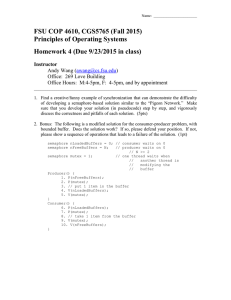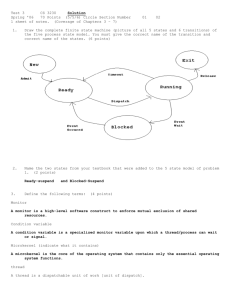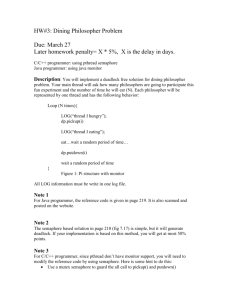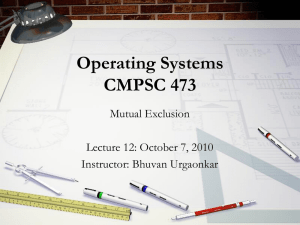Fast User-Level Inter-thread Communication, Synchronisation
advertisement
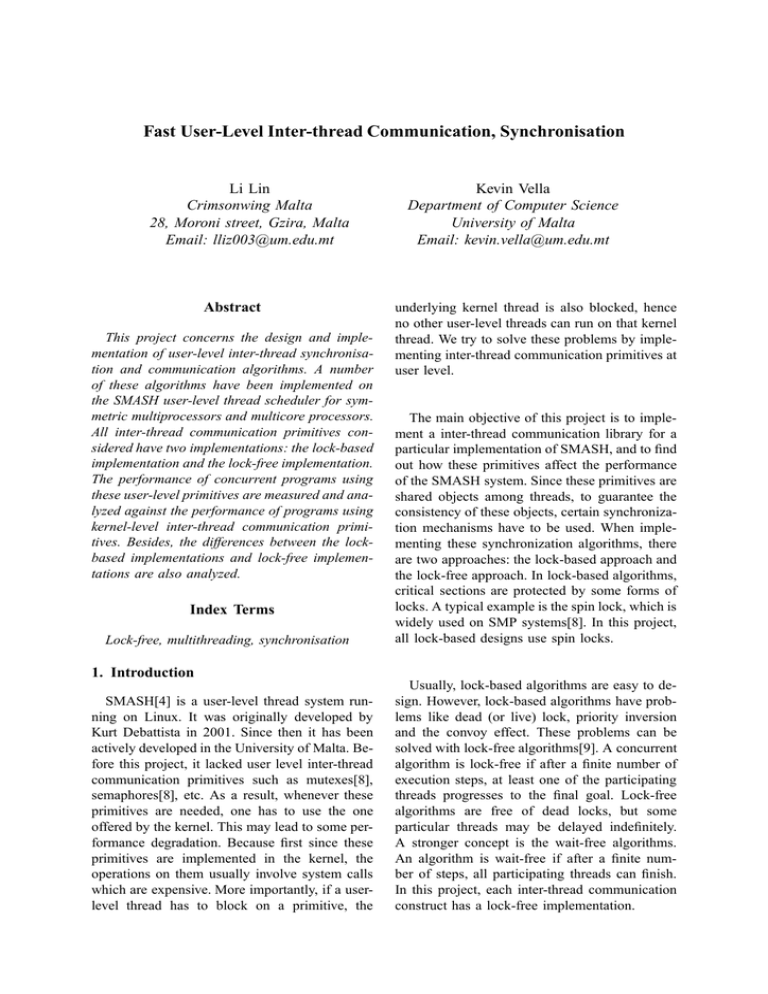
Fast User-Level Inter-thread Communication, Synchronisation
Li Lin
Crimsonwing Malta
28, Moroni street, Gzira, Malta
Email: lliz003@um.edu.mt
Abstract
This project concerns the design and implementation of user-level inter-thread synchronisation and communication algorithms. A number
of these algorithms have been implemented on
the SMASH user-level thread scheduler for symmetric multiprocessors and multicore processors.
All inter-thread communication primitives considered have two implementations: the lock-based
implementation and the lock-free implementation.
The performance of concurrent programs using
these user-level primitives are measured and analyzed against the performance of programs using
kernel-level inter-thread communication primitives. Besides, the differences between the lockbased implementations and lock-free implementations are also analyzed.
Index Terms
Lock-free, multithreading, synchronisation
Kevin Vella
Department of Computer Science
University of Malta
Email: kevin.vella@um.edu.mt
underlying kernel thread is also blocked, hence
no other user-level threads can run on that kernel
thread. We try to solve these problems by implementing inter-thread communication primitives at
user level.
The main objective of this project is to implement a inter-thread communication library for a
particular implementation of SMASH, and to find
out how these primitives affect the performance
of the SMASH system. Since these primitives are
shared objects among threads, to guarantee the
consistency of these objects, certain synchronization mechanisms have to be used. When implementing these synchronization algorithms, there
are two approaches: the lock-based approach and
the lock-free approach. In lock-based algorithms,
critical sections are protected by some forms of
locks. A typical example is the spin lock, which is
widely used on SMP systems[8]. In this project,
all lock-based designs use spin locks.
1. Introduction
SMASH[4] is a user-level thread system running on Linux. It was originally developed by
Kurt Debattista in 2001. Since then it has been
actively developed in the University of Malta. Before this project, it lacked user level inter-thread
communication primitives such as mutexes[8],
semaphores[8], etc. As a result, whenever these
primitives are needed, one has to use the one
offered by the kernel. This may lead to some performance degradation. Because first since these
primitives are implemented in the kernel, the
operations on them usually involve system calls
which are expensive. More importantly, if a userlevel thread has to block on a primitive, the
Usually, lock-based algorithms are easy to design. However, lock-based algorithms have problems like dead (or live) lock, priority inversion
and the convoy effect. These problems can be
solved with lock-free algorithms[9]. A concurrent
algorithm is lock-free if after a finite number of
execution steps, at least one of the participating
threads progresses to the final goal. Lock-free
algorithms are free of dead locks, but some
particular threads may be delayed indefinitely.
A stronger concept is the wait-free algorithms.
An algorithm is wait-free if after a finite number of steps, all participating threads can finish.
In this project, each inter-thread communication
construct has a lock-free implementation.
2. Design and implementation
All communication primitives introduced in
this project have their lock-based implementations in which critical sections are protected by
spin locks. These lock-based implementations are
very simple, hence we will not discuss their details. In contrast, their lock-free designs are complicated. Therefore in this paper, we mainly focus
on them. In addition, we implemented a waitfree CSP communication channel[6] designed by
Vella[3].
2.1. Lock-free Mutex
Algorithm 1 Lock free Mutex
L1 struct lockfree_mutex {
L2 int lock;
L3 int counter;
L4 struct fifo waiting_queue;
}
L5 FetchAndAdd(&mutex->counter,1);
L6 if(Swap(&mutex->lock,LOCKED))
L7
FetchAndAdd(&mutex->counter,-1);
L8 else {
L9
enqueue(thread_self,mutex->waiting_queue);
L10
schedule the next runnable thread;
L11 }
L12 counter = mutex->counter;
L13 if(counter == 0)
L14
if(!CAS2(<&mutex->lock,&mutex->counter>,
<0,0>,<1,0>)) {
L15
do {
L16
thread = dequeue(mutex->waiting_queue);
L17
}while(thread == NULL);
L18
FetchAndAdd(&mutex->counter, -1);
L19
enqueue(thread,run_queue);
L20
}
We designed a lock-free mutex in this project.
The challenges in the design are how to modify the status of the mutex and manipulate the
waiting queue concurrently in a lock-free manner.
In addition, the lost-wake-up problem has to
be solved. The instruction Swap was used to
modify the lock field in the mutex. The waiting
queue was adopted from [1]. In order to solve
the lost-wake-up problem[8], we added to the
mutex structure a field counter which represents
the number of threads trying to acquire the
mutex. When a thread calls Getmutex function,
it first increments the counter by 1 with the
atomic instruction Fetch_And_Add. Then it tries
to obtain the mutex with Swap, if successful, the
Algorithm 2 The lock-free semaphore
L1 struct sem_t {
L2 int counter;
L3 struct fifo waiting_queue;
L4 }
L5 wait(sem_t s) {
L6
/* we may also use FetchAndAdd here, but I suspect
that the following code can improve the latency. */
L7
do {
L8
counter = s->counter;
L9
}while(!cas(&s->counter,counter,counter-1));
L10
if(counter < 0)
L11
save the current contex;
L12
enqueue(thread_self, s->waiting_queue);
L13
switch to the next runnable thread;
L14
else
L15
return
L16 }
L17 signal(sem_t s) {
L18 do{
L19
old = s->counter
L20
do{
L21
if( s->counter< 0 )
L22
tmp_thread = dequeue(s->waiting_queue);
L23
if(tmp_thread == NULL)
L24
continue;
L25
else
L26
FetchAndAdd(&s->counter, 1);
L27
wakeup(tmp_thread);
L28
return;
L29
else
L30
break;
L31
}while(true);
L32 }while(!CAS(&s->counter,old,old+1))
L33 }
counter is decremented by 1 with Fetch_And_Add
again. Otherwise, the thread blocks on the mutex
by inserting itself to the waiting queue. When
a thread calls Releasemutex function, it checks
whether the counter is zero, if so, then the lock
field is set to zero, i.e. the mutex is released.
This process is done with CAS2 to guarantee
the atomicity. CAS2 fails to release the mutex
iff the counter is non-zero which means there
exists threads trying to obtain the mutex, but they
may have or have not inserted themselves into the
waiting queue. Hence, we used an indefinite loop
to dequeue a thread from the waiting queue. The
loop terminates if a thread has been successfully
dequeued from the waiting queue. And finally the
dequeued thread is woken up by being inserted
into the run queue.
2.2. Lock-free semaphores
In the design of our lock-free semaphore, the
waiting queue is the same lock-free FIFO queue
as the one used our lock-free mutex. the counter
is modified with Compare_and_Swap and is allowed to take negative value. If the counter is
negative, then its modules represents the number
of threads that are currently waiting for the
semaphore, but some of them may not have
inserted themselves into the waiting queue. When
a thread tries to release a semaphore, it first reads
the counter. If the counter is negative, then it tries
to dequeue a thread from the waiting queue. If
it gets a thread successfully, then it wakes up
that thread and increments the counter by 1 with
Fetch_And_Add, after which the function returns
directly avoiding the outer loop between L18 and
L32. However, if it fails to get a waiting thread,
then there are two possibilities: the waiting thread
has not inserted itself into the waiting queue, or
the waiting has been emptied by other threads
releasing the semaphore. Therefore, in the loop
between L20 to L31, before the dequeue operation, the counter is checked first. If it is not
negative any more, then the loop is broken out.
In the otter loop, the counter is updated with
Compare_and_Swap. This guarantees that after
the inner loop is broken out, the counter has
not been changed by any other threads, hence
the semaphore can be released safely without the
lost-wake-up problem.
2.3. Lock-free message queue
The message queues we implemented are unbounded, multiple sender, single receiver queues.
Unboundedness means that these queues are potentially capable of storing infinitely many messages. The only limit is the memory space. Also
there can be more than one sender that sends
messages to the queue concurrently, but there is
only one receiver. If the receiver tries to retrieve
a message from a empty queue, it blocks until a
sender wakes it up.
In order to implement the lock-free message
queue, we use the lock-free queue from [1] to
store messages and add a field waiting_mark
to the queue structure. When a thread tries to
fetch a message from the queue, it first sets the
waiting_mark to WAITING to denote that the
receiver is fetching messages. Then it performs
Algorithm 3 the lock-free message queue
struct message_queue {
struct lockfree_fifo * queue;
cthread * waiting_thread;
int waiting_mark;
}
Fetch_message(struct message_queue * q) {
while(true) {
queue->waiting_mark = WAITING;
result = dequeue(q->queue);
if(result == NULL)
save the current context;
q->waiting_thread = thread_self;
switch to the next runnable thread;
continue on wakeup
else
queue->waiting_mark = NOWAITING;
reture result;
}
Send_message(message, struct message_queue q) {
enqueue(message, q->queue);
do {
thread = swap(&queue->waiting_thread,NULL);
if(thread != NULL)
queue->waiting_mark = NOWAITING;
wakeup(thread);
while(queue->waiting_mark == WAITING);
}
the dequeue operation. If no message is found,
then it blocks on the queue. When a sender
sends a message, it inserts the message into the
queue, then check the waiting_mark. If its value
is WAITING, then the sender swaps NULL to the
field waiting_thread. If the obtained value is not
NULL which means that the receiver is blocking
on the queue. Therefore the sender inserts the
waiting thread into the run queue. Finally, the
field waiting_mark is set to NOWAITING. Otherwise, the sender repeats the above process until
the value of waiting_mark is NOWAITING.
2.4. Wait-free channels
In this project, we also implemented Vella’s
wait-free CSP channel[3]. It was designed for
KRoC which is an implementation for the OCCAM 2 programming language. The design was
totally wait-free, it did not contain any form of
locks or indefinite loops. In the design, the only
special atomic instruction used was Swap. For
details of the design, one can refer to [3].
Figure 1. Benchmarks of the system when
using different mutexes
1.1e+06
Pthread mutex
User-level mutex
1e+06
900000
Time(microsecond)
800000
700000
600000
500000
400000
300000
200000
100000
0
500000
1e+06
1.5e+06
2e+06
2.5e+06
3e+06
3.5e+06
4e+06
4.5e+06
5e+06
Granularity
3. Results
The machine we used to conduct the benchmarks is a laptop equipped with a Intel
Core2 Duo 1.83Ghz CPU with 4Mb L2 cache,
2Gb memory. The operating system is Debian
GNU/Linux unstable with Linux kernel version
2.6.24. The compiler is GCC 4.3. When measuring these benchmarks, we try to run as few
programs as possible, the largest program running
being the X-window system.
3.1. Mutexes
We created six identical independent tasks,
each of which contains nothing but a critical
section protected by a mutex. In the critical
section, a thread loops to increment a counter
which is not shared. For each critical section, we
create ten user-level threads working on it. The
program loops for a number which is defined by
GRANULARITY. We used a pthread mutex and
our lock-free mutex to analyze the performance.
It is desirable that the choice of different implementations of user-level mutexes will not make
a significant difference since we are measuring
the performance of the entire system, not that of
mutexes.
From the results, we can see that on average, the performance of the system when using
the user-level mutex is twice that when using
pthread’s mutex. This is because user-level mutexes never block the kernel threads. In fact,
in the best case, it is possible that when using
pthread’s mutex, each kernel picks up a different
task to do, therefore, there is no contention on
these mutexes. In this case, we can still get the
same performance as with user-level mutexes.
However, in the worst case these tasks will be
processed one by one in a strictly sequential
manner, i.e. we do not benefit from the other CPU
at all. This happens when the two kernel threads
always try to work on the same task, so one of
them is always blocked.
Another benchmark is to measure the performance of the function Getmutex and Releasemutex when the mutex is not under contention. In
this case, it is not enough to time a single function
call to Getmutex since the time of executing the
function is not large enough to compensate the
time that is cost by calling the function gettimeofday()[5]. In order to measure the benchmark
accurately, we have to perform a large number of
function call to Getmutex, then calculate the average time for a single call. However, this approach
is not valid, because once we call Getmutex, it
will lock the mutex. Hence, we call Getmutex
followed by a call to Releasemutex, and we use
a loop with 1000000 iterations to execute such
a pair, and then calculate the average time for a
single pair.
Table 1. Benchmark for mutexes(ns)
Pthread mutex
74
Lock-based
95
Lock-free
127
As we can see, the lock-free mutex is
slower than the lock-based mutex for the
case in which there is no contention, this is
reasonable because the lock-free mutex uses
a lot of expensive atomic operations like
Fetch_And_Add, Compare_And_Swap and Double_Compare_And_Swap. In addition, the algorithm is also more complicated, while in contrast,
the lock-based mutex just uses Swap and is therefore simpler. The pthread mutex is the fastest for
the uncontended case, because Linux 2.6 series
kernels features a new technique called futex[2],
[7] (fast user space mutex). Prior to Linux 2.6,
a call to pthread_mutex_lock had to enter the
kernel and operate on the pthread mutex, then
return to user mode even the mutex is not under
contention. But by using futexes, all operation
will remain in user mode for uncontended case
and the pthread mutex on SMP system is also
implemented though spin locks. The code is written directly assembly language and it is manually
optimized, that is why it is the fastest.
3.2. Semaphores
Table 2. Benchmarks of semaphores(ns)
Lock-free
90
Lock-based
96
System
383
We use the same algorithm as the one used
in the above section to measure the impact of
user-level semaphores to the performance of the
SMASH system, the only thing changed is that in
this case we use semaphores initialized to some
number to protect the critical section.
Due to the hardware limit, we are not able
to measure the benchmark for a semaphore
whose counter was initialized larger than one,
because we only have a dual core machine, hence
SMASH will only create two kernel threads and
all user-level threads are run by these two kernel
threads. So if a semaphore is initialized to a
number larger than 1, there will not be any
contention on the semaphore. As a result, we
only conducted the benchmark with semaphores
initialized with 1, but in this case, the semaphores
behave just as mutexes, hence we have similar
result patterns as above.
In fact, on the SMASH system, no matter how
many user-level threads access a semaphore, if
the semaphore is initialized to a number smaller
than the number of CPUs (i.e. the number of kernel threads), then there will not be any contention
on it since the number of threads accessing the
semaphore concurrently is always smaller than
the initial number of the semaphore’s counter.
However, our design is not limited to SMASH,
it can be used in other contexts, and we do
expect that in a system with a large set of CPUs,
our lock-free design will perform better than the
lock-based one because it reduces the memory
contention. Even on a uniprocessor system, to
implement a kind of system semaphore for kernel
threads like pthreads on Linux, our design may
also be a better solution than simply disabling
the interrupts when a kernel thread accesses a
semaphore, because disabling interrupts is also
very expensive on uniprocessor systems.
In addition, we used the same mechanism in
the previous section to conduct the benchmarks
of the lock-free, lock-based semaphores and the
system semaphore.From the result, we can see the
lock-free implementation slightly outperformed
the lock-based implementation and the system
semaphore is the slowest. This is because operations on system semaphores are done by using
system calls which are expensive.
3.3. Message queues
In this section, we are going to measure and
compare the performance on the lock-based and
lock-free message queues. We conducted the
benchmarks for sending messages and for receiving messages. To conduct the former one,
we created 25000 user-level threads, each of
which sends a message to the message queue.
To conduct the latter, we use a thread to dequeue a large number of messages which are preenqueued into the message queue, hence in this
case the thread receiving messages never blocks.
Finally, the average time of a signal operation is
calculated
Table 3. Results of message queues(ns)
Enqueue operation
Lock-based
1321
Dequeue operation
Lock-based
133
Lock-free
1257
Lock-free
135
From the result, we can see that the difference
between the lock-based approach and the lockfree approach is not significant for both sending
messages and receiving messages. In fact, the
dominating factor for the performance of our
message queues is the performance of the FIFO
queues used to store messages. Although according to [1], the lock-free FIFO queue we used is
much faster than the FIFO queue with spin locks
when a large number of threads access the queue
concurrently. In our case, since we have only
two kernel threads running concurrently when
sending messages, and only one thread is running
when receiving messages (in which case, there is
no contention at all), it is not surprising that these
two queues give similar performance. Another
thing to note is from the result is that sending a
message is much more expensive than dequeuing
a message from the queue. However, this is not
accurate, because when we were conducting the
benchmark for sending messages, we timed both
the message sending operations in each user-level
thread, and the operation that the main thread
of SMASH joins these 25000 user-level threads
and the thread scheduling operations, which are
quite expensive. On the other hand, when we conducted the benchmark for the receiving operation,
we only timed the dequeuing operation.
4. Conclusion
We implemented several user-level inter-thread
communication primitives for SMASH, and
gained some improvements to the overall performance of the SMASH system. Additionally,
we also exploited lock-free algorithms by implementing the primitives we introduced in a lockfree manner. Although due to the limitation of
the hardware we currently have, the advantage
of these lock-free implementations can not be
shown, we still believe that lock-free algorithms
perform better than lock-based algorithms when
a multiprocessor system is under high contention.
References
[1] Dominique Fober, Yann Qrlarey, Stephane Letz.
Lock Free Techniques for Concurrent Access
to Shared Objects. Technical report. GRAME Computer Music Research Lab. 2001.
[2] Hubertus Franke and Rusty Russell. Fuss, Futexes
and Furwocks: Fast Userlevel Locking in Linux.
Ottawa Linux Symposium. 2002.
[3] Kevin Vella. Seamless parallel computing on heterogeneous networks of mutiprocessor workstations. PhD thesis, University of Kent at Canterbury, 1998.
[4] Kurt Debattista, High Performance Thread
Scheduling on Share Memory Multiprocessors.
Master’s thesis, University of Malta, 2001.
[5] Marc J. Rochkind, Advanced UNIX Programming. Second Edition. ISBN 7-302-12645-3. 2004
[6] SGS-THOMSON Microelectronics Limited, Occam 2.1 Reference Manual, 1995.
[7] Ulrich Drepper, Futexes Are Tricky. Red Hat, Inc.
2008.
[8] Uresh Vahalia, Unix Internals: The New Frontiers.
Prentice Hall. ISBN 0-13-101908-2. 1995.
[9] John D. Valois, Lock-free Data Structures. PhD
thesis, Rensselaer Polytechnic Institute, Troy,
New York, USA, 1995.
